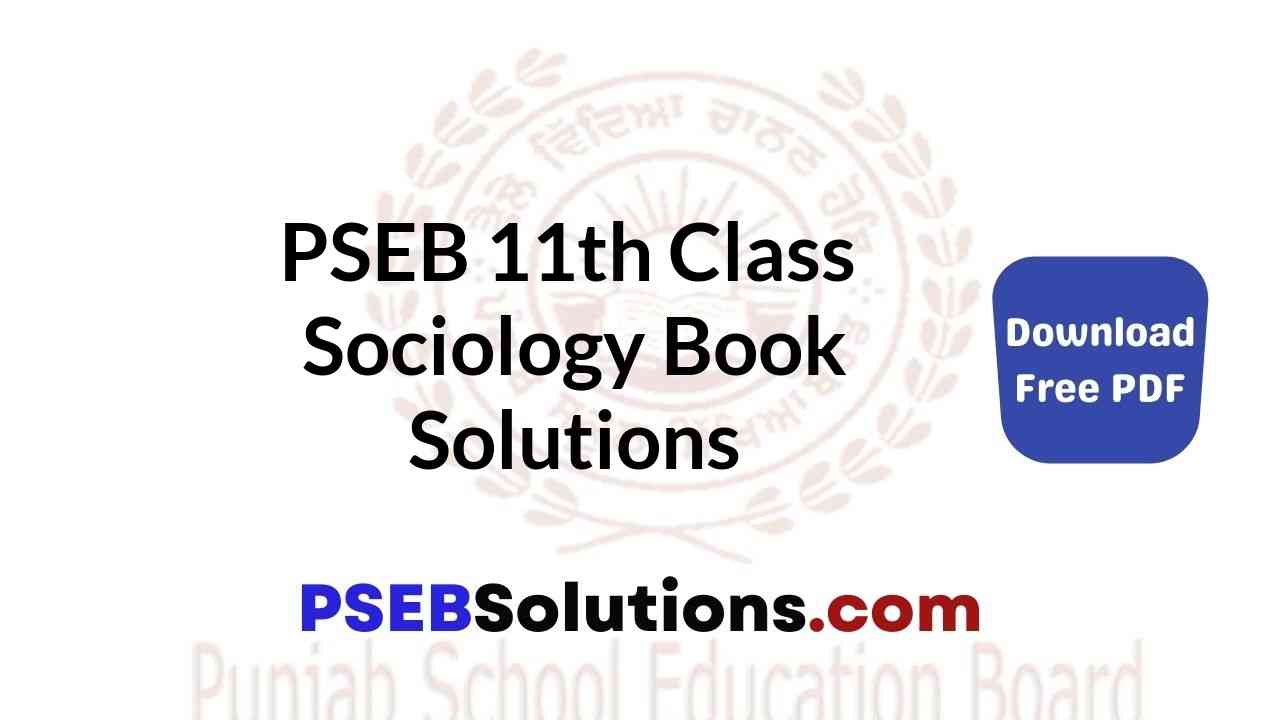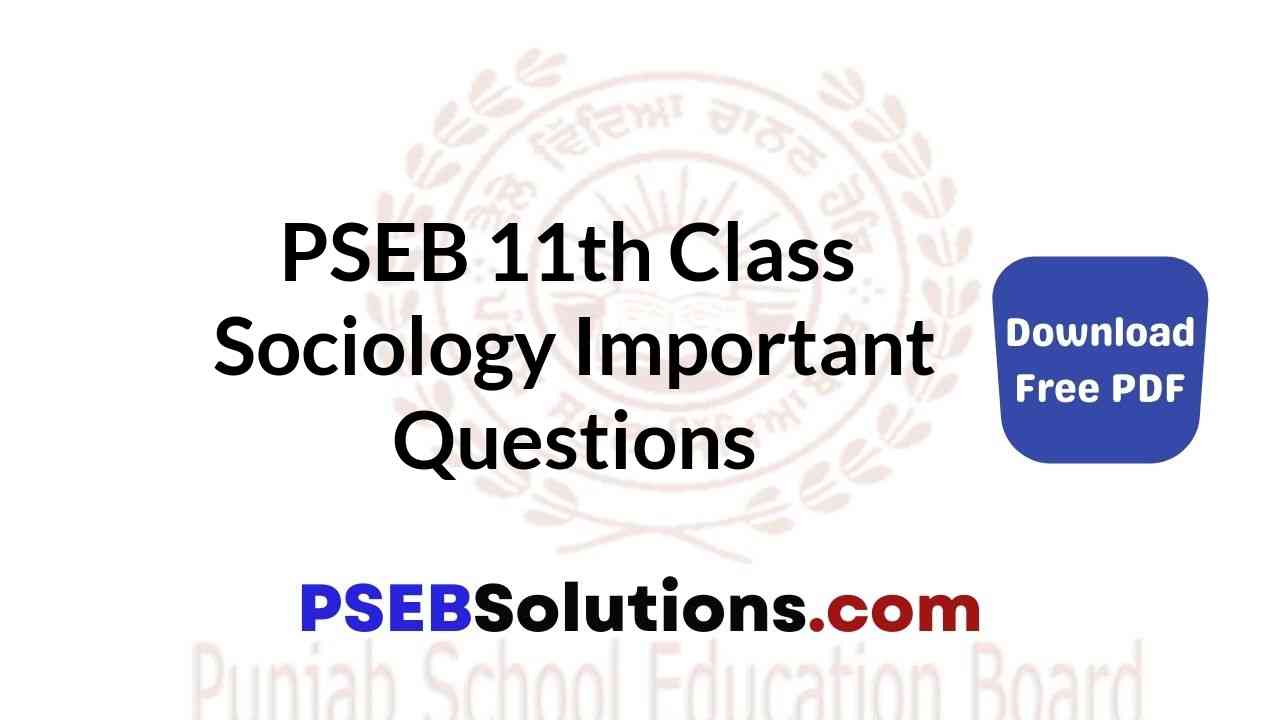Punjab State Board Syllabus PSEB 11th Class Sociology Book Solutions Guide Pdf in English Medium and Punjabi Medium are part of PSEB Solutions for Class 11.
PSEB 11th Class Sociology Guide | Sociology Guide for Class 11 PSEB
Sociology Guide for Class 11 PSEB | PSEB 11th Class Sociology Book Solutions
PSEB 11th Class Sociology Book Solutions in English Medium
Unit 1 Origin and Emergence of Sociology
Unit 2 Basic Concepts in Sociology
Unit 3 Culture, Socialization and Social Institutions
- Chapter 5 Culture
- Chapter 6 Socialization
- Chapter 7 Marriage, Family and Kinship
- Chapter 8 Polity, Religion, Economy and Education
Unit 4 Social Structure, Social Stratification, Social Change and Founding Fathers of Sociology
- Chapter 9 Social Structure
- Chapter 10 Social Stratification
- Chapter 11 Social Change
- Chapter 12 Western Sociological Thinkers
- PSEB 11th Class Sociology Source Based Questions
PSEB 11th Class Sociology Book Solutions in Hindi Medium
- Chapter 1 समाजशास्त्र का उद्भव
- Chapter 2 समाजशास्त्र का अन्य समाज विज्ञानों से संबंध
- Chapter 3 समाज, समुदाय तथा समिति
- Chapter 4 सामाजिक समूह
- Chapter 5 संस्कृति
- Chapter 6 समाजीकरण
- Chapter 7 विवाह, परिवार तथा नातेदारी
- Chapter 8 राजनीति, धर्म, अर्थ प्रणाली तथा शिक्षा
- Chapter 9 सामाजिक संरचना
- Chapter 10 सामाजिक स्तरीकरण
- Chapter 11 सामाजिक परिवर्तन
- Chapter 12 पश्चिमी समाजशास्त्री विचारक
- स्रोत आधारित प्रश्न
PSEB 11th Class Sociology Book Solutions Guide in Punjabi Medium
- Chapter 1 ਸਮਾਜ ਸ਼ਾਸਤਰ ਦੀ ਉਤਪਤੀ
- Chapter 2 ਸਮਾਜ ਸ਼ਾਸਤਰ ਦਾ ਦੂਜੇ ਸਮਾਜਿਕ ਵਿਗਿਆਨਾਂ ਨਾਲ ਸੰਬੰਧ
- Chapter 3 ਸਮਾਜ, ਸਮੂਦਾਇ ਅਤੇ ਸਭਾ
- Chapter 4 ਸਮਾਜਿਕ ਸਮੂਹ
- Chapter 5 ਸਭਿਆਚਾਰ
- Chapter 6 ਸਮਾਜੀਕਰਨ
- Chapter 7 ਵਿਆਹ, ਪਰਿਵਾਰ ਅਤੇ ਨਾਤੇਦਾਰੀ
- Chapter 8 ਰਾਜਨੀਤਿਕ, ਧਾਰਮਿਕ, ਆਰਥਿਕ ਅਤੇ ਸਿੱਖਿਆ ਸੰਸਥਾਵਾਂ
- Chapter 9 ਸਮਾਜਿਕ ਸੰਰਚਨਾ
- Chapter 10 ਸਮਾਜਿਕ ਸਤਰੀਕਰਨ
- Chapter 11 ਸਮਾਜਿਕ ਪਰਿਵਰਤਨ
- Chapter 12 ਪੱਛਮੀ-ਸਮਾਜ ਵਿਗਿਆਨ ਦੇ ਵਿਚਾਰਕ
- PSEB 11th Class Sociology Source Based Questions
PSEB 11th Class Sociology Syllabus
Unit I: Origin and Emergence
1. Emergence of Sociology: Historical Background, Meaning, Nature and Scope of Sociology.
2. Relationship of Sociology with other Social Sciences: Political Science, History, Economics, Psychology, and Anthropology.
Unit II: Basic Concepts in Sociology
3. Society, Community, and Association: Society-Meaning and Features, Relationship between individual and society; Community-Meaning and features; Association-Meaning and Features, Difference between Society, Community and Association.
4. Social Groups: Meaning and Features, Types- Primary and Secondary groups, In-group and Out-group.
Unit III: Culture, Socialisation, and Social Institutions
5. Culture; Meaning and features, Material and Non-Material culture.
6. Socialisation: Meaning, Socialisation is a process of learning, Agencies of Socialisation: Formal and Informal Agencies.
7. Marriage, Family, and Kinship.
8. Polity, Religion, Economy, and Education.
Unit IV: Social Structure, Social Stratification, and Social Change and Founding Fathers of Sociology
9. Social Structure: Meaning, features and Elements-Status, and Role.
10. Social Stratification: Concept, Forms, Caste and Class, Features and Differences.
11. Social Change: Meaning, Features, and Factors-Demographic, Educational and Technological.
12. Western Sociological Thinkers: Auguste Comte-Positivism, Law of Three Stages, Karl Marx-Class and Class conflict, Emile Durkheim-Social Facts, Division of Labour, Max Weber-Social Action, Types of Authority, Sociology of Religion.
Project Work/Internal Assessment (20 Marks)
Mode of Presentation/Submission of the Project:
At the end of the stipulated term, each learner will present the research work to the Project File Internal examiner. The questions should be asked from the Research Work/ Project File of the learner. The Internal Examiner should ensure that the study submitted by the learner is his/her own original work. In case of any doubt, authenticity should be checked and verified.
Practical Examination
Allocation of Marks (20)
The marks will be allocated under the following heads:
| A | Project (as prescribed in the book) | 10 Marks |
| Research Design | ||
| Overall format | 1 Mark | |
| Research question/Hypothesis | 1 Mark | |
| Choice of the technique | 2 Marks | |
| Detailed procedure for implementation of the technique | 2 Marks | |
| Limitations of the above technique | 2 Marks | |
| Viva | 2 Marks | |
| B | Social Work-Related Activities/Practical work | 8 Marks |
| C | Book bank | 2 Marks |
| Total | 20 Marks | |
PSEB 11th Class Sociology Structure of Question Paper
Time: 3 Hours
Theory: 80 Marks
Project Work/IA: 20 Marks
Total: 100 Marks
1. All questions are compulsory.
2. The question paper is divided into four sections A, B, C, and D.
3. There are 38 questions in all. Some questions have an internal choice. Marks are indicated against each question.
Section – A
Objective Type Questions: This section comprises questions No. 1 – 20. These are objective-type questions that carry 1 mark each. This type may include questions with one word to one sentence answers/Fill in the blanks/True or false/Multiple choice type questions. (20 × 1 = 20)
Section – B
Very Short Answer Type Questions: This section comprises questions No. 21 – 29. These are very short answer type questions carrying 2 marks each. The answer to each question should not exceed 30 words. (9 × 2 = 18)
Section – C
Short Answer Type Questions: This section includes questions No. 30 – 35. They are short answer-type questions carrying 4 marks each. The answer to each question should not exceed 80 words. (6 × 4 = 24)
Section – D
Long Answer Type Questions: This section questions No. 36 – 38. This type of question (with internal choice) long answer type questions carrying 6 marks each. The answer to each question should not exceed 150-200 words each. Question no 38 is to be answered with the help of the passage given. (3 × 6 = 18)
PSEB 11th Class Sociology Question Wise Break up
| Typology of Question | Marks Per Question | Total no. of Questions | Total Marks |
| Objective Type (Learning checks) | 1 | 20 | 20 |
| Very Short Answer (VSA) | 2 | 9 | 18 |
| Short Answer (SA) | 4 | 6 | 24 |
| Long Answer (LA) | 6 | 3 | 18 |
| Total | 80 | ||
PSEB 11th Class Sociology Weightage to Content
| Section A | 20 Marks |
| Section B | 20 Marks |
| Section C | 20 Marks |
| Section D | 20 Marks |
| Project Work | 20 Marks |
| Total | 100 Marks |
PSEB 11th Class Sociology Weightage of Difficulty Level
| Estimated Difficulty Level | Percentage |
| Easy (E) | 30% |
| Average (AV) | 50% |
| Difficult (D) | 20% |
PSEB 11th Class Sociology Course Structure
| Unit | Name of the Unit | Periods | Marks |
| Unit I | Tribal Society | 20 | |
| Unit II | Basic Concepts in Sociology | 20 | |
| Unit III | Culture, Socialisation and Social Institutions | 20 | |
| Unit IV | Social Structure, Social Stratification, Social Change and Founding Fathers of Sociology | 20 |

